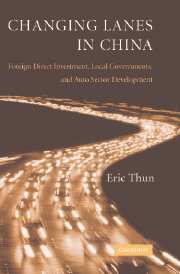Book contents
- Frontmatter
- Contents
- List of Figures and Tables
- List of Abbreviations
- Preface
- PART I INTRODUCTION
- PART II DEVELOPMENT IN A PROTECTED MARKET
- 3 Coordinating Development in the Auto Sector
- 4 Shanghai: A Local Developmental State
- 5 Beijing and Guangzhou: Laissez-Faire Local States
- 6 Changchun and Wuhan: Firm-Dominated Localities
- PART III DEEPENING GLOBAL INTEGRATION
- PART IV CONCLUSION
- Appendix on Research Methods
- Bibliography
- Index
6 - Changchun and Wuhan: Firm-Dominated Localities
Published online by Cambridge University Press: 12 November 2009
- Frontmatter
- Contents
- List of Figures and Tables
- List of Abbreviations
- Preface
- PART I INTRODUCTION
- PART II DEVELOPMENT IN A PROTECTED MARKET
- 3 Coordinating Development in the Auto Sector
- 4 Shanghai: A Local Developmental State
- 5 Beijing and Guangzhou: Laissez-Faire Local States
- 6 Changchun and Wuhan: Firm-Dominated Localities
- PART III DEEPENING GLOBAL INTEGRATION
- PART IV CONCLUSION
- Appendix on Research Methods
- Bibliography
- Index
Summary
The auto joint ventures in Changchun and Wuhan, although more recently created, are also more heavily burdened by history. Changchun has long served as a key industrial base and transportation hub for northeast China. It was the capital city of the Japanese-controlled Manchukuo from 1931 to 1945, and like the rest of Manchuria, it emerged from the Japanese occupation with a relatively well-developed industrial base. The young Communist regime sought to capitalize upon these advantages when it decided to locate the First Auto Works (FAW) in the city in the early 1950s. The “auto city,” constructed with the help of Soviet advisors, was the pride of socialist China, producing sturdy blue trucks for the workers and Red Flag limousines for the leaders. By the 1990s, however, the city was at the center of China's rust belt, and the impact of the reform movement was relatively slight. While the municipal auto offices in Guangzhou were moved in the 1990s to a gleaming new skyscraper in the city's rapidly growing business district, the municipal auto offices of Changchun continued to be located in a stolid old building at no. 57 Stalin Street.
Wuhan, located at the intersection of the Yangtze River and the trunk line of the Beijing-Guangzhou railroad, has long served as a transportation link and commercial entrepot for inland China.
- Type
- Chapter
- Information
- Changing Lanes in ChinaForeign Direct Investment, Local Governments, and Auto Sector Development, pp. 172 - 204Publisher: Cambridge University PressPrint publication year: 2006

